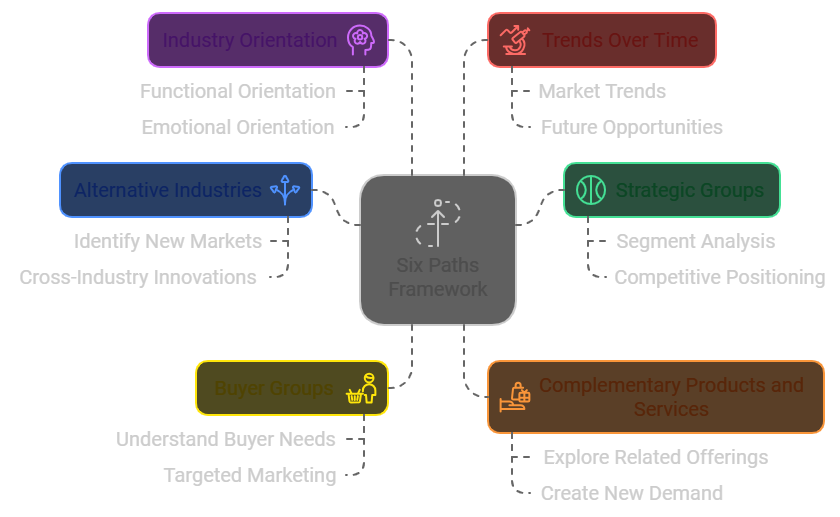Explaining the Six Principles of Blue Ocean Strategy
Are you tired of competing in overcrowded markets? Blue Ocean Strategy might be just what you need. It focuses on creating uncontested market space and making the competition irrelevant. We will break down the six principles of Blue Ocean Strategy in this article. Whether you’re a seasoned entrepreneur or just starting out, these principles offer a fresh perspective on how to succeed in today’s competitive business world.
Understanding the Blue Ocean Way

The Big Six of Blue Ocean
The six paths framework offers six systematic ways to change how you look at the market. Each path explains how to find new opportunities by breaking industry boundaries. This process helps organizations move away from traditional competition-based thinking and gain insights into opening new demand.
Instead of focusing within conventional boundaries, the framework encourages looking across different industries, strategic groups, buyer groups, complementary products, industry orientations, and trends over time. The Big Six of Blue Ocean helps understand and navigate markets, compare different players, and consider the needs of all types of buyers.
Dive Into Different Markets

The six paths framework provides six systematic ways to shift your lens when examining the market universe and opening up a new value-cost frontier. Path by path, the framework explains how to uncover plausible blue ocean opportunities by looking across an industry’s self-imposed boundaries instead of remaining stuck within them.
This process enables companies to break away from conventional competition-based thinking, shift their perspective, and gain insights into reconstructing conventional boundaries to open new demand. Instead of looking within traditional boundaries, the six paths framework helps companies look across alternative industries, strategic groups, buyer groups, complementary product and service offerings, an industry’s functional-emotional orientation, and even across time to effectively assess and cater to the diverse needs and preferences of different markets.
Companies can create a blue ocean strategy by challenging assumptions, thinking creatively, and uncovering new perspectives and opportunities using the six paths framework.
Compare Different Market Players

The six paths framework offers six systematic ways to change your perspective on the market and create new value-cost opportunities.
By exploring across industry boundaries, you can uncover blue ocean opportunities and break free from traditional competition-based thinking. This framework encourages looking across alternative industries, strategic groups, buyer groups, complementary products, and services, industry orientation, and time.
By following these paths, market players can position themselves as pioneers in creating new market space instead of competing within existing boundaries.
Think About All the Buyers
It involves breaking away from conventional competition-based thinking, shifting perspectives, and gaining insights. It helps businesses look across alternative industries, strategic groups, and buyer groups. It also encourages looking across complementary product and service offerings, an industry’s functional-emotional orientation, and even across time.
Consider Things That Go Together
There are many related products and services in the marketplace, such as smartphones and mobile apps, coffee machines and coffee pods, and gaming consoles and video games.
Companies can create value for customers and capture new demand by identifying and satisfying buyers’ unmet needs. By doing so, they can develop new markets instead of competing in existing ones, which gives them a clear advantage over traditional competitive strategies.
Using the six paths framework to examine complementary product and service offerings, companies can identify overlooked opportunities and create a blue ocean strategy that breaks away from traditional industry boundaries. This different perspective encourages innovation and value creation, leading to long-term success and growth for the organization.
Balance Fun and Serious Stuff in Business

Incorporating fun elements into the workplace can positively impact employee morale and productivity. It creates a more enjoyable and stress-free environment. This can be achieved through team-building activities, casual dress days, or a fun break area where employees can relax and unwind. These practices can help boost employee motivation and engagement, improving work performance.
Practical strategies for balancing fun activities and the serious aspects of running a successful business include setting clear expectations and boundaries for when and how these activities can occur. Ensuring that fun elements align with the overall business goals and objectives is also important.
Additionally, leadership can encourage feedback from employees to find a balance that works for everyone.
Creating a work environment encouraging creativity and innovation involves promoting an open and collaborative culture. This can include providing spaces for brainstorming sessions, idea sharing, and recognizing and rewarding creative thinking. Establishing guidelines for appropriate behaviors and communication in the workplace is also essential to maintaining a professional reputation.
Always Keep an Eye on Tomorrow

Businesses need to keep an eye on the future. This helps them anticipate trends and changes in the market, which can give them a competitive advantage. Looking ahead also allows companies to identify new opportunities and devise innovative strategies. To stay ahead, businesses can explore alternative industries, strategic groups, and buyer groups. Considering complementary products and services, industry emotions, and trends over time also helps.
This approach allows businesses to gain insights, create new demand, and innovate.

Vizologi is a revolutionary AI-generated business strategy tool that offers its users access to advanced features to create and refine start-up ideas quickly.
It generates limitless business ideas, gains insights on markets and competitors, and automates business plan creation.


